Progress and Development of Solid-Fuel Scramjet Technologies
Abstract
1. Introduction
2. Overall Configuration of the Solid-Fuel Scramjet
3. Supersonic Stable Combustion and Combustion Enhancement Technology
4. Engine Thermal Protection Technology
4.1. Passive Thermal Protection
4.2. Active Thermal Protection
4.3. Combined Active and Passive Thermal Protection
5. Improvement of Solid-Fuel and Combustion Performance
6. Outlook and Summary
- (1)
- Optimization of Engine Configuration and Exploration of Combustion Organization Strategies for Wide-Speed-Range Solid Rocket Ramjet Engines
- (2)
- Optimization of Thermal Protection Design and Breakthroughs in Combustion Chamber Efficient Load-Bearing and Thermal Barrier Integration Technologies
- (3)
- Optimization of Oxygen-Deficient Solid-Fuel Formulations to Enhance Energy Density and Combustion Efficiency
- (4)
- Addressing Combustion Instability Issues to Improve Combustion Stability and Efficiency
- (5)
- Exploring Innovations and Applications of Regenerative Cooling Technology to Optimize Cooling Structure Temperature
Author Contributions
Funding
Conflicts of Interest
Abbreviations
| MDPI | Multidisciplinary Digital Publishing Institute |
| DOAJ | Directory of open access journals |
| TLA | Three-letter acronym |
| LD | Linear dichroism |
| SFSJ | Solid-fuel scramjet |
| SRSJ | Solid ducted rocket scramjet |
| DMRJ | Solid dual-combustor scramjet |
References
- Mcclintonc, R.; Rausch, V.L.; Nguyen, T.; Joel, R. Preliminary X-43 flight test results. Acta Astronaut. 2005, 57, 266–276. [Google Scholar] [CrossRef]
- Marshall, L.; Bahm, C.; Corpening, G. Overview with Results and Lessons Learned of the X-43AMach 10 Flight: AIAA-2005-3336; AIAA: Reston, VA, USA, 2005. [Google Scholar]
- Marshall, L.; Corpening, G.; Sherrill, R. Achief ENGINEER’S view of the NASA X-43A Scramjet Flighttest: AIAA-2005-3332; AIAA: Reston, VA, USA, 2005. [Google Scholar]
- Rondeau, C.M.; Iorris, T.R. X-5lA scramjet demonstrator program: Waverider ground and flight test. In Proceedings of the AIAA/CIRA 13th International Space Planes and Hypersonics Systems and Technologies Conference, Capua, Italy, 16–20 May 2005. [Google Scholar]
- Urzay, J. Supersonic combustion in air-breathing propulsion systems for hypersonic flight. Annu. Rev. Fluid Mech. 2018, 50, 593–627. [Google Scholar] [CrossRef]
- Seleznev, R.K. History of scramjet propulsion development. In Proceedings of the 1lth International Conference Aerophysics and Physical Mechanics of Classical and Quantum Systems, Moscow, Russia, 21–24 November 2017; IOP Publishing Ltd.: Bristol, UK, 2018. [Google Scholar]
- Roudakov, A.S.; Semenov, V.L.; Hicks, J.W. Recent Flight Test Results of the Joint CIAM-NASA Mach 6.5 Scramjet Flight Program: AIAA-1998-1643; AIAA: Reston, VA, USA, 1998. [Google Scholar]
- Smart, M.K.; Hass Ne Paull, A. Flight dataanalysis of the HyShot 2 scramjet flight experiment. AIAA J. 2006, 44, 2366–2375. [Google Scholar] [CrossRef]
- Pecnik, R.; Terraponv, E.; Ham, F.; Laccarino, G.; Pitsch, H. Reynolds-averaged Navier-Stokes simulations of theHyShot Il scramjet. AIAA J. 2012, 50, 1717–1732. [Google Scholar] [CrossRef]
- Chapuis, M.; Fedina, E.; Fureby, C.; Hannemann, K.; Karl, S.; Martinez Schramm, J. A computational study of the HyShot IIcombustor performance. Proc. Combust. Inst. 2013, 34, 2101–2109. [Google Scholar] [CrossRef]
- Witt, M.A. Investigation into the Feasibility of Using Solid Fuel Ramjets for High Supersonic/Low Hypersonic Tactical Issiles; Deft. of Astronautical Engineering, Nava Postgraduate School: Monterey, CA, USA, 1989. [Google Scholar]
- Jarymowycz, T.; Yang, V.; Kuo, K.K. A Numerical Study of Solid Fuel Combustion Under Supersonic Crossflows. In Proceedings of the 26th AIAA/SAE/ASME/ASEE Joint Propulsion Conference, Orlando, FL, USA, 16–18 July 1990. [Google Scholar]
- Angus, W.J. An Investigion into the Performance Characteristics of a Solid Fuel Scramjet Propulsion Device; Deft. of Astronautical Engineering, Nava Postgraduate School: Monterey, CA, USA, 1991. [Google Scholar]
- Ben-Yakar, A.; Natan, B.; Gany, A. Investigation of a Solid Fuel Seramjet Combustor. J. Propuls. Power 1998, 14, 447–455. [Google Scholar] [CrossRef]
- Cohen-Zur, A.; Natan, B. Experimental Investigation of a Supersonic Combustion Solid FuelRamjet fI. J. Propuls. Power. 1998, 14, 880–889. [Google Scholar] [CrossRef]
- Lv, Z.; Xia, Z.; Liu, B.; Liu, Y. Experimental and numerical investigation of a solid-fuel rocket scramjet combustor. J. Propuls. Power 2016, 32, 273–278. [Google Scholar] [CrossRef]
- Lv, Z.; Xia, Z.; Liu, B.; Huang, L. Preliminary experimental study on solid-fuel rocket scramjet combustor. Joumal Zhejiang Univ.-Sci. A (Appl. Phys. Eng.) 2017, 18, 106–112. [Google Scholar] [CrossRef]
- Desikan, S.L.N.; Kurian, J. Mixing Studies in Supersonic Flow Employing Strut Based Hyper-Mixers; AIAA 2005-3643; AIAA: Reston, VA, USA, 2005. [Google Scholar]
- Cai, Z.; Wang, T.; Sun, M. Review of cavity ignition in supersonic flows. Acta Astronaut. 2019, 165, 268–286. [Google Scholar] [CrossRef]
- Abdel-Salam, T.M.; Tiwari, S.N.; Mohieldim, T.O. Effects of ramp swept angle in supersonic mixing. In Proceedings of the 21st AIAA Aerodynamic Measurement Technology and Ground Testing Conference, Denver, CO, USA, 19–22 June 2000. [Google Scholar]
- Li, L.-Q.; Huang, W.; Yan, L.; Du, Z.-B.; Fang, M. Numerical investigation and optimization on the micro-ramp vortex generator within scramjet combustors with the transverse hydrogen jet. Aerosp. Sci. Technol. 2018, 79, 145–153. [Google Scholar] [CrossRef]
- Tan, J.; Zhang, D.; Lv, L. A review on enhanced mixing methods in supersonic mixing layer flows. Acta Astronaut. 2018, 152, 310–324. [Google Scholar] [CrossRef]
- Huang, W. Mixing enhancement strategies and their mechanisms in supersonic flows: A brief review. Acta Astronaut. 2018, 145, 492–500. [Google Scholar] [CrossRef]
- Feng, R.; Li, J.; Wu, Y.; Zhu, J.; Song, X.; Li, X. Experimental investigation on gliding arc discharge plasma ignition and flame stabilization in scramjet combustor. Aerosp. Sci. Technol. 2018, 79, 145–153. [Google Scholar] [CrossRef]
- Huang, W.; Li, Y. Numerical investigation on the ram–scram transition mechanism in a strut-based dual-mode scramjet combustor. Int. J. Hydrogen Energy 2016, 41, 4799–4807. [Google Scholar] [CrossRef]
- Wang, Y.; Song, W. Experimental investigation of influence factors on flame holding in a supersonic combustor. Aerosp. Sci. Technol. 2019, 85, 180–186. [Google Scholar] [CrossRef]
- Wang, Z.; Sun, M.; Wang, H.; Yu, J.; Liang, J.; Zhuang, F. Mixing-related low frequency oscillation of combustion in an ethylene-fueled supersonic combustor. Proc. Combust. Inst. 2015, 35, 2137–2144. [Google Scholar] [CrossRef]
- Sun, M.; Zhong, Z.; Liang, J.; Wang, H. Experimental investigation on combustion performance of cavity-strut injection of supercritical kerosene in supersonic model combustor. Acta Astronaut. 2016, 127, 112–119. [Google Scholar] [CrossRef]
- Wang, H.; Wang, Z.; Sun, M.; Qin, N. Large eddy simulation of a hydrogen-fueled scramjet combustor with dual cavity. Acta Astronaut. 2015, 108, 119–128. [Google Scholar] [CrossRef]
- Chen, S.; Zhao, D. RANS investigation of the effect of pulsed fuel injection on scramjet HyShot II engine. Aerosp. Sci. Technol. 2019, 84, 182–192. [Google Scholar] [CrossRef]
- Choubey, G.; Devarajan, Y.; Huang, W.; Mehar, K.; Tiwari, M.; Pandey, K. Recent advances in cavity-based scramjet engine—A brief review. Int. J. Hydrogen Energy 2019, 44, 13895–13909. [Google Scholar] [CrossRef]
- Yu, K.H.; Schadow, K.C.; Wilson, K.J. Effect of Flame-Holding Cavities on Supersonic-Combustion Performance. J. Propuls. Power 2012, 17, 1287–1295. [Google Scholar] [CrossRef]
- Pei, X.; Hou, L. Numerical investigation on cavity structure of solid-fuel scramjet combustor. Acta Astronaut. 2014, 105, 463–475. [Google Scholar] [CrossRef]
- Situ, M.; Wang, C.; Lu, H.; Yu, G.; Zhang, X. Hot gas piloted energy for supersonic combustion of kerosene with dual-cavity. In Proceedings of the 39th Aerospace Sciences Meeting and Exhibit, Reno, NV, USA, 8–11 January 2001. [Google Scholar]
- Pei, X.; Wu, Z.; Wei, Z.; Wang, N.; Liu, J. Numerical Investigation on Cavity Length for Solid Fuel scramjet. In Proceedings of the 48th AIAA/ASME/SAE/ASEE Joint Propulsion Conference & Exhibit, Atlanta, GA, USA, 30 July–1 August 2012. [Google Scholar]
- Pei, X.; Wu, Z.; Wei, Z.; Liu, J. Numerical Investigation on Internal Regressing Shapes of Solid-FuelScramjet Combustor. J. Propuls. Power. 2013, 29, 1041–1051. [Google Scholar] [CrossRef]
- Fan, Z.Q.; Liu, W.D.; Lin, Z.Y.; Sun, M.B. Experimental investigation on supersonic combustion flame structure with cavity injectors. J. Propuls. Technol. 2013, 34, 62–68. [Google Scholar]
- Liu, Y.; Gao, Y.; Chai, Z.; Dong, Z.; Hu, C.; Yu, X. Mixing and heat release characteristics in the combustor of solid-fuel rocket scramjet based on DES. Aerosp. Sci. Technol. 2019, 94, 105391. [Google Scholar] [CrossRef]
- Yonggang, G.; Yang, L.; Zexin, C.; Xiaocong, L.; Chunbo, H.; Xiaojing, Y. Influence of lobe geometry on mixing and heat release characteristics of solid fuel rocket scramjet combustor. Acta Astronaut. 2019, 164, 212–229. [Google Scholar] [CrossRef]
- Levin, V.A.; Lutsenko, N.A.; Salgansky, E.A.; Yanovskiy, L.S. A Model of Solid-Fuel Gasification in the Combined Charge of a Low-Temperature Gas Generator of a Flying Vehicle. Dokl. Phys. 2018, 63, 375–379. [Google Scholar] [CrossRef]
- Salgansky, E.A.; Lutsenko, N.A.; Levin, V.A.; Yanovskiy, L.S. Modeling of solid fuel gasification in combined charge of low-temperature gas generator for high-speed ramjet engine. Aerosp. Sci. Technol. 2019, 84, 31–36. [Google Scholar] [CrossRef]
- Li, C.; Xia, Z.; Ma, L.; Zhao, X.; Chen, B. Experimental and numerical study of solid rocket scramjet combustor equipped with combined cavity and strut device. Acta Astronaut. 2019, 162, 145–154. [Google Scholar] [CrossRef]
- Li, C.; Xia, Z.; Ma, L.; Zhao, X.; Chen, B. Numerical Study on the Solid Fuel Rocket scramjet Combustor with Cavity. Energies 2019, 12, 1235. [Google Scholar] [CrossRef]
- Li, C.; Zhao, X.; Xia, Z.; Ma, L.; Chen, B. Influence of the vortex generator on the performance of solid rocket scramjet combustor. Acta Astronaut. 2019, 164, 174–183. [Google Scholar] [CrossRef]
- Liu, J.; Wang, N.-F.; Wang, J.; Li, Z.-Y. Optimizing combustion performance in a solid rocket scramjet engine. Aerosp. Sci. Technol. 2020, 99, 105560. [Google Scholar] [CrossRef]
- Aravind, S.; Kumar, R. Supersonic combustion of hydrogen using an improved strut injection scheme. Int. J. Hydrogen Energy 2019, 44, 6257–6270. [Google Scholar] [CrossRef]
- Kato, N.; Im, S.K. Flame dynamics under various backpressures in a model scramjet with and without a cavity flameholder. Proc. Combust. Inst. 2021, 38, 3861–3868. [Google Scholar] [CrossRef]
- Nakaya, S.; Yamana, H.; Tsue, M. Experimental Investigation of Ethylene/Air Combustion Instability in a Model scramjet Combustor Using Image-Based Methods. Proc. Combust. Inst. 2021, 38, 3869–3880. [Google Scholar] [CrossRef]
- Lakka, S.; Randive, P.; Pandey, K.M. Implication of geometrical configuration of cavity on combustion performance in a strut-based scramjet combustor-Science Direct. Acta Astronaut. 2021, 178, 793–804. [Google Scholar] [CrossRef]
- Van der lee, J.; Yokev, N.; Michaels, D. Combustion instability due to combustion mode transition in a cavity-stabilized scramjet. J. Propuls. Power 2022, 38, 945–956. [Google Scholar] [CrossRef]
- Ogawa, S. Dynamic Mode Decomposition of the Combustion Flow Field in a scramjet Combustor with a Cavity Flameholder. In Proceedings of the AIAA Aviat. 2023 Forum, San Diego, CA, USA, 2–16 June 2023; American Institute of Aeronautics and Astronautics: Reston, VA, USA, 2023. [Google Scholar]
- Kumar, R.; Pranaykumar, S.; Ghosh, A. Mode Transition in Cavity Based Dual Mode scramjet Combustor. In Proceedings of the AIAA Aviat. 2023 Forum, San Diego, CA, USA, 2–16 June 2023; American Institute of Aeronautics and Astronautics: Reston, VA, USA, 2023. [Google Scholar]
- Ji, J.; Cai, Z.; Wang, T.; Wang, Z.; Sun, M. Experimental Study on Combustion Modes and Oscillations in a Cavity-Based scramjet Combustor. AIAA J. 2024, 62, 91. [Google Scholar] [CrossRef]
- Kim, M.-S.; Lee, E.-S.; Han, H.-S.; Lee, K.-H.; Choi, J. Ignition Characteristics of Tandem Cavity scramjet Combustor using micro-PDE. In Proceedings of the AIAA SCITECH 2024 Forum, Orlando, FL, USA, 8–12 January 2024; American Institute of Aeronautics and Astronautics: Reston, VA, USA, 2024. [Google Scholar]
- Alunno, E.; La Sorsa, A.; Sprunger, J.; Hytovick, R.; Ahmed, K. A Scramjet Cavity Flame Stabilization with Ethylene Fuel. In Proceedings of the AIAA SCITECH 2024 Forum, Orlando, FL, USA, 8–12 January 2024; American Institute of Aeronautics and Astronautics: Reston, VA, USA, 2024. [Google Scholar]
- Kelly, H.N.; Blosser, M.L. Active Cooling from the Sixties to NASP. In Current Technology for Thermal Protection Systems; NASA CP 3157; NASA: Washington, DC, USA, 1992. [Google Scholar]
- Shemet, V.Z.; Pomytkin, A.P.; Neshpor, V.S. High-Temperature Oxidation Behaviour of Carbon Materials in Air. Carbon 1993, 31, 1–6. [Google Scholar] [CrossRef]
- Valdevit, L.; Vermaak, N.; Hsu, K.; Zok, F.W.; Evans, A.G. Design of Actively Cooled Panels for Scramjets; AIAA 2006-8069; AIAA: Reston, VA, USA, 2006. [Google Scholar]
- Dirling, R.B. Progress in Materials and Structrures Evaluation for the HyTech Program; AIAA 1998-1591; AIAA: Reston, VA, USA, 1998. [Google Scholar]
- Haug, T.; Ehmann, U.; Knabe, H. Air Intake Ramp Made from C/SiC via the Polymer Route for Hypersonic Propulsion Systems; AIAA 1993-5036; AIAA: Reston, VA, USA, 1993. [Google Scholar]
- Chen, F.F.; Tam, W.F.; Shimp, N.P. An Innovative Thermal Management System for a Mach 4 to Mach 8 Hypersonic Scramjet Engine; AIAA 1998-3734; AIAA: Reston, VA, USA, 1998. [Google Scholar]
- Fahrenhohz, W.G.; Hilmas, G.E.; Talmy, I.G.; Zaykoski, J.A. Refractory Diborides of Zirconium and Hafnium. J. Am. Ceram. Soc. 2007, 90, 1347–1364. [Google Scholar] [CrossRef]
- Sciti, D.; Brach, M.; Bellosi, A. Oxidation Behavior of a Pressureless Sintered ZrB2MoSi2 Ceramic Composite. J. Mater. Res. 2005, 20, 922–930. [Google Scholar] [CrossRef]
- Kourtides, D.A.; Tran, H.K.; Chiu, S.A. Composite Flexible Insulation for Thermal Protection of Space Vehicles; NASA-TM-103836; NASA: Washington, DC, USA, 1991. [Google Scholar]
- Zhu, Y.H.; Peng, W.; Xu, R.N.; Jiang, P. Review on Active Thermal Protection and its Heat Transfer for Airbreathing Hypersonic Vehicles. Chin. J. Aeronaut. 2018, 31, 1929–1953. [Google Scholar] [CrossRef]
- Huang, H.; Sobel, D.R.; Spadaccini, L.J. Endothermic Heat-Sink of Hydrocarbon Fuels for Scramjet Cooling; AIAA 2002-3871; AIAA: Reston, VA, USA, 2002. [Google Scholar]
- Aupoix, B.; Mignosi, A.; Viala, S.; Bouvier, F.; Gaillard, R. Experimental and Numerical Study of Supersonic Film Cooling. AIAA J. 1998, 36, 915–923. [Google Scholar] [CrossRef]
- Cheuret, F.; Steelant, J.; Langener, T. Numerical Investigations on Transpiration Cooling for Scramjet Applications Using Different Coolants; AIAA 2011-2379; AIAA: Reston, VA, USA, 2011. [Google Scholar]
- Zhang, S.L.; Li, X.; Zuo, J.Y.; Qin, J.; Cheng, K.; Feng, Y.; Bao, W. Research Progress on Active Thermal Protection for Hypersonic Vehicles. Prog. Aerosp. Sci. 2020, 119, 100646. [Google Scholar] [CrossRef]
- Sobel, D.R.; Spadaccini, L.J. Hydrocarbon Fuel Cooling Technologies for Advanced Propulsion. In Proceedings of the International Gas Turbine and Aeroengine Congress & Exposition, Houston, TX, USA, 5–8 June 1995. [Google Scholar]
- Fry, R.S. Navy’s Contribution to Airbreathing Missile Propulsion Technology. In Proceedings of the AIAA Centennial of Naval Aviation Forum “100 Years of Achievement and Progress”, Virginia Beach, VA, USA, 21–22 September 2011. AIAA 2011-6942. [Google Scholar]
- Wenerberg, J.C.; Jung, H.; Schuff, R.; Anderson, W.; Merkle, C.L. Study of Simulated Fuel Flows in High Aspect Ratio Cooling Channels; AIAA 2006-4708; AIAA: Reston, VA, USA, 2006. [Google Scholar]
- Chen, Y.; Wang, Y.; Bao, Z.W.; Zhang, Q.; Li, X.-Y. Numerical Investigation of Flow Distribution and Heat Transfer of Hydrocarbon Fuel in Regenerative Cooling Panel. Appl. Therm. Eng. 2016, 98, 628–635. [Google Scholar] [CrossRef]
- Deng, H.W.; Zhang, C.B.; Xu, G.Q.; Tao, Z.; Zhu, K.; Wang, Y. Visualization Experiments of a Specific Fuel Flow Through Quartz-Glass Tubes Under both Sub- and Supercritical Conditions. Chin. J. Aeronaut. 2012, 25, 372–380. [Google Scholar] [CrossRef]
- Wang, N.; Zhou, J.; Pan, Y.; Wang, H. Determination of Critical Properties of Endothermic Hydrocarbon Fuel RP3 Based on Flow Visualization. Int. J. Thermophys. 2014, 35, 13–18. [Google Scholar] [CrossRef]
- Deng, H.W.; Zhu, K.; Xu, G.Q.; Tao, Z.; Zhang, C.B.; Liu, G.Z. Isobaric Specific Heat Capacity Measurement for Kerosene RP-3 in the Near-Critical and Supercritical Regions. J. Chem. Eng. Data 2012, 57, 263–268. [Google Scholar] [CrossRef]
- Zhou, W.X.; Bao, W.; Qin, J.; Qu, Y. Deterioration in Heat Transfer of Endothermal Hydrocarbon Fuel. J. Therm. Sci. 2011, 20, 173–180. [Google Scholar] [CrossRef]
- Liu, Z.H.; Bi, Q.C.; Guo, Y.; Yan, J.; Yang, Z. Convective Heat Transfer and Pressure Drop Characteristics of Near-Critical-Pressure Hydrocarbon Fuel in a Mini Channel. Appl. Therm. Eng. 2013, 51, 1047–1054. [Google Scholar] [CrossRef]
- Hines, W.S.; Wolf, H. Pressure Oscillations Associated with Heat Transfer to Hydrocarbon Fluid at Supercritical Pressures and Temperatures. J. Am. Rocket Soc. 1962, 32, 361–366. [Google Scholar] [CrossRef]
- Yang, Z.Q.; Bi, Q.C.; Liu, Z.H.; Guo, Y.; Yan, J. Heat Transfer to Supercritical Pressure Hydrocarbons Flowing in a Horizontal Short Tube. Exp. Therm. Fluid Sci. 2015, 61, 144–152. [Google Scholar] [CrossRef]
- Chatoorgoon, V. Non-dimensional Parameters for Static Instability in Supercritical Heated Channels. Int. J. Heat Mass Transf. 2013, 64, 145–154. [Google Scholar] [CrossRef]
- Zhou, W.X.; Yu, B.; Qin, J.; Yu, D. Mechanism and Influencing Factors Analysis of Flowing Instability of Supercritical Endothermic Hydrocarbon Fuel within a Small-Scale Channel. Appl. Therm. Eng. 2014, 71, 34–42. [Google Scholar] [CrossRef]
- Garimella, S.; Mitra, B.; Andresen, U.C.; Jiang, Y.; Fronk, B.M. Heat Transfer and Pressure Drop During Supercritical Cooling of HFC Refrigerant Blends. Int. J. Heat Mass Transf. 2015, 91, 477–493. [Google Scholar] [CrossRef]
- Wang, H.; Zhou, J.; Pan, Y.; Wang, N. Experimental Investigation on the Onset of Thermo-acoustic Instability of Supercritical Hydrocarbon Fuel Flowing in a Small-scale Channel. Acta Astronaut. 2015, 117, 296–304. [Google Scholar] [CrossRef]
- Zhong, F.Q.; Fan, X.J.; Yu, G.; Li, J.; Sung, C.-J. Thermal Cracking and Heat Sink Capacity of Aviation Kerosene Under Supercritical Conditions. J. Thermophys. Heat Transf. 2011, 25, 450–456. [Google Scholar] [CrossRef]
- Gascoin, N.; Gillard, P.; Bernard, S.; Bouchez, M. Characterisation of Coking Activity during Supercritical Hydrocarbon Pyrolysis. Fuel Process. Technol. 2008, 89, 1416–1428. [Google Scholar] [CrossRef]
- Minicucci, D.; Zou, X.Y.; Shaw, J.M. The Impact of Liquid-liquid-vapour Phase Behaviour on Coke Formation from Model Coke Precursors. Fluid Phase Equilibria 2002, 194–197, 353–360. [Google Scholar] [CrossRef]
- Shinen, S.R.; Nidhi, S.S. Review on Film Cooling of Liquid Rocket Engines. Propuls. Power Res. 2018, 7, 1–18. [Google Scholar] [CrossRef]
- Bunker, R.S. A Review of Shaped Hole Turbine Film-Cooling Technology. J. Heat Transf. 2005, 127, 441–453. [Google Scholar] [CrossRef]
- Zhang, H.W.; Tao, W.Q.; He, Y.L.; Zhang, W. Numerical Study of Liquid Film Cooling in a Rocket Combustion Chamber. Int. J. Heat Mass Transf. 2006, 49, 349–358. [Google Scholar] [CrossRef]
- Yin, L.; Liu, W.Q. Gaseous Film Cooling Investigation in a Multi-element Splash Platelet Injector. Acta Astronaut. 2018, 144, 353–362. [Google Scholar] [CrossRef]
- Modlin, J.M.; Colwell, G.T. Surface Cooling of scramjet Engine Inlet using Heat Pipe, Transpiration, and Film Cooling. J. Thermophys. Heat Transf. 1992, 6, 500–504. [Google Scholar] [CrossRef]
- Yuen, C.H.N.; Martinez-Botas, R.F. Film Cooling Characteristics of Rows of Round Holes at Various Streamwise Angles in a Crossflow: Part I. Effectiveness. Int. J. Heat Mass Transf. 2005, 48, 4995–5016. [Google Scholar] [CrossRef]
- Na, S.; Shin, T.I.P. Increasing Adiabatic Film-cooling Effectiveness by using an Upstream Ramp. J. Heat Transf.-Trans. ASME 2007, 129, 464–471. [Google Scholar] [CrossRef]
- Schuchkin, V.; Osipov, M.; Shyy, W.; Thakur, S. Mixing and Film Cooling in Supersonic Duct Flows. Int. J. Heat Mass Transf. 2002, 45, 4451–4461. [Google Scholar] [CrossRef]
- Langener, T.; Wolfersdorf, J.V.; Steelant, J. Experimental Investigations on Transpiration Cooling for scramjet Applications Using Different Coolants. AIAA J. 2011, 49, 1409–1419. [Google Scholar] [CrossRef]
- Huang, Z.; Xiong, Y.B.; Liu, Y.Q.; Jiang, P.-X.; Zhu, Y.-H. Experimental Investigation of Full-Coverage Effusion Cooling through Perforated Flat Plates. Appl. Therm. Eng. 2015, 76, 76–85. [Google Scholar] [CrossRef]
- Xiao, X.F.; Zhao, G.B.; Zhou, W.X. Numerical Investigation of Transpiration Cooling for Porous Nose Cone with Liquid Coolant. Int. J. Heat Mass Transf. 2018, 121, 1297–1306. [Google Scholar] [CrossRef]
- Zhao, L.J.; Wang, J.H.; Ma, J.; Lin, J.; Peng, J.; Qu, D.; Chen, L. An Experimental Investigation on Transpiration Cooling under Supersonic Condition using a Nose Cone Model. Int. J. Therm. Sci. 2014, 84, 207–213. [Google Scholar] [CrossRef]
- Jiang, P.X.; Yu, L.; Sun, J.G.; Wang, J. Experimental and Numerical Investigation of Convection Heat Transfer in Transpiration Cooling. Appl. Therm. Eng. 2004, 24, 1271–1289. [Google Scholar] [CrossRef]
- Jiang, P.X.; Liao, Z.Y.; Huang, Z.; Xiong, Y.; Zhu, Y. Influence of Shock Waves on Supersonic Transpiration Cooling. Int. J. Heat Mass Transf. 2019, 129, 965–974. [Google Scholar] [CrossRef]
- Jiang, P.X.; Huang, G.; Zhu, Y.H.; Liao, Z.; Huang, Z. Experimental Investigation of Combined Transpiration and Film Cooling for Sintered Metal Porous Struts. Int. J. Heat Mass Transf. 2017, 108, 232–243. [Google Scholar] [CrossRef]
- Zhang, C.; Qin, J.; Yang, Q.C.; Zhang, S.; Bao, W. Design and Heat Transfer Characteristics Analysis of Combined Active and Passive Thermal Protection System for Hydrogen Fueled scramjet. Int. J. Hydrogen Energy 2015, 40, 675–682. [Google Scholar] [CrossRef]
- Paquette, E. Cooled CMC Structures for Scramjet Engine Flowpath Components; AIAA 2005-3432; AIAA: Reston, VA, USA, 2005. [Google Scholar]
- Bouquet, C.; Fischer, R.; Luc-Bouhali, A.; Dessornes, O.; Thebault, J.; Soyris, P. Fully Ceramic Composite Heat Exchanger Qualification for Advanced Combustion Chambers; AIAA 2005-3433; AIAA: Reston, VA, USA, 2005. [Google Scholar]
- Rosenband, V. Thermo-Mechanical Aspects of the Heterogeneous Ignition of Metals. Combust. Flame 2004, 137, 366–375. [Google Scholar] [CrossRef]
- Cassel, H.M.; Liebman, I. Combustion of Magnesium Particles I. Combust. Flame 1962, 6, 153–156. [Google Scholar] [CrossRef]
- Brzustowski, T.; Glassman, I. Heterogeneous Combustion Conference; American Institute of Aeronautics and Astronautics: Reston, VA, USA, 1963. [Google Scholar]
- Rosenband, V.; Gany, A.; Timnat, Y.M. A Model for Low-Temperature Ignition of Magnesium Particles. Combust. Sci. Technol. 1995, 105, 279–294. [Google Scholar] [CrossRef]
- Badiola, C.; Gill, R.J.; Dreizin, E.L. Combustion Characteristics of Micron-Sized Aluminum Particles in Oxygenated Environments. Combust. Flame 2011, 158, 2064–2070. [Google Scholar] [CrossRef]
- Mohan, S.; Furet, L.; Dreizin, E.L. Aluminum Particle Ignition in Different Oxidizing Environments. Combust. Flame 2010, 157, 1356–1363. [Google Scholar] [CrossRef]
- Glassman; Williams, F.A.; Antaki, P. A Physical and Chemical Interpretation of Boron Particle Combustion. Symp. (Int.) Combust. 1985, 20, 2057–2064. [Google Scholar] [CrossRef]
- Li, S.C.; Williams, F.A. Ignition and Combustion of Boron in Wet and Dry Atmospheres. Symp. (Int.) Combust. 1991, 23, 1147–1154. [Google Scholar] [CrossRef]
- Yeh, C.L.; Kuo, K.K. Ignition and Combustion of Boron Particles. Prog. Energy Combust. Sci. 1996, 22, 511–541. [Google Scholar] [CrossRef]
- Ulas; Kuo, K.K.; Gotzmer, C. Ignition and Combustion of Boron Particles in Fluorine-Containing Environments. Combust. Flame 2001, 127, 1935–1957. [Google Scholar] [CrossRef]
- Ulas, A.; Gotzmer, C. Effects of Fluorine-Containing Species on the Ignition and Combustion of Boron Particles: Experiment and Theory. Int. J. Energetic Mater. Chem. Propuls. 2002, 5, 453–463. [Google Scholar] [CrossRef]
- Ao, W.; Zhou, J.H.; Liu, J.Z.; Yang, W.J.; Wang, Y.; Li, H.P. Kinetic Model of Single Boron Particle Ignition Based upon Both Oxygen and (BO)(n) Diffusion Mechanism. Combust. Explos. Shock. Waves 2014, 50, 262–271. [Google Scholar] [CrossRef]
- Dreizin, E.L.; Keil, D.G.; Felder, W.; Vicenzi, E.P. Phase Changes in Boron Ignition and Combustion. Combust. Flame 1999, 119, 272–290. [Google Scholar] [CrossRef]
- Dreizin, E.L.; Calcote, H.F. A New Mechanism of Boron Ignition: Through the Formation of a Saturates Bo Solution. In Proceedings of the Eastern States Section Meeting, Schenectady, NY, USA, 14–17 October 1995. [Google Scholar]
- Ao, W.; Wang, Y. Effect of gas generator pressure on the physicochemical, oxidation and combustion characteristics of boron-based propellant primary combustion products. J. Therm. Anal. Calorim. 2017, 129, 1865–1874. [Google Scholar] [CrossRef]
- Ao, W.; Wang, Y.; Wu, S. Ignition kinetics of boron in primary combustion products of propellant based on its unique characteristics. Acta Astronaut. 2017, 136, 450–458. [Google Scholar] [CrossRef]
- Xu, P.; Liu, J.; Zhang, L.; Yuan, J.; Song, M.; Liu, H. Composition of solid and gaseous primary combustion products of boron-based fuel-rich propellant. Acta Astronaut. 2021, 188, 36–48. [Google Scholar] [CrossRef]
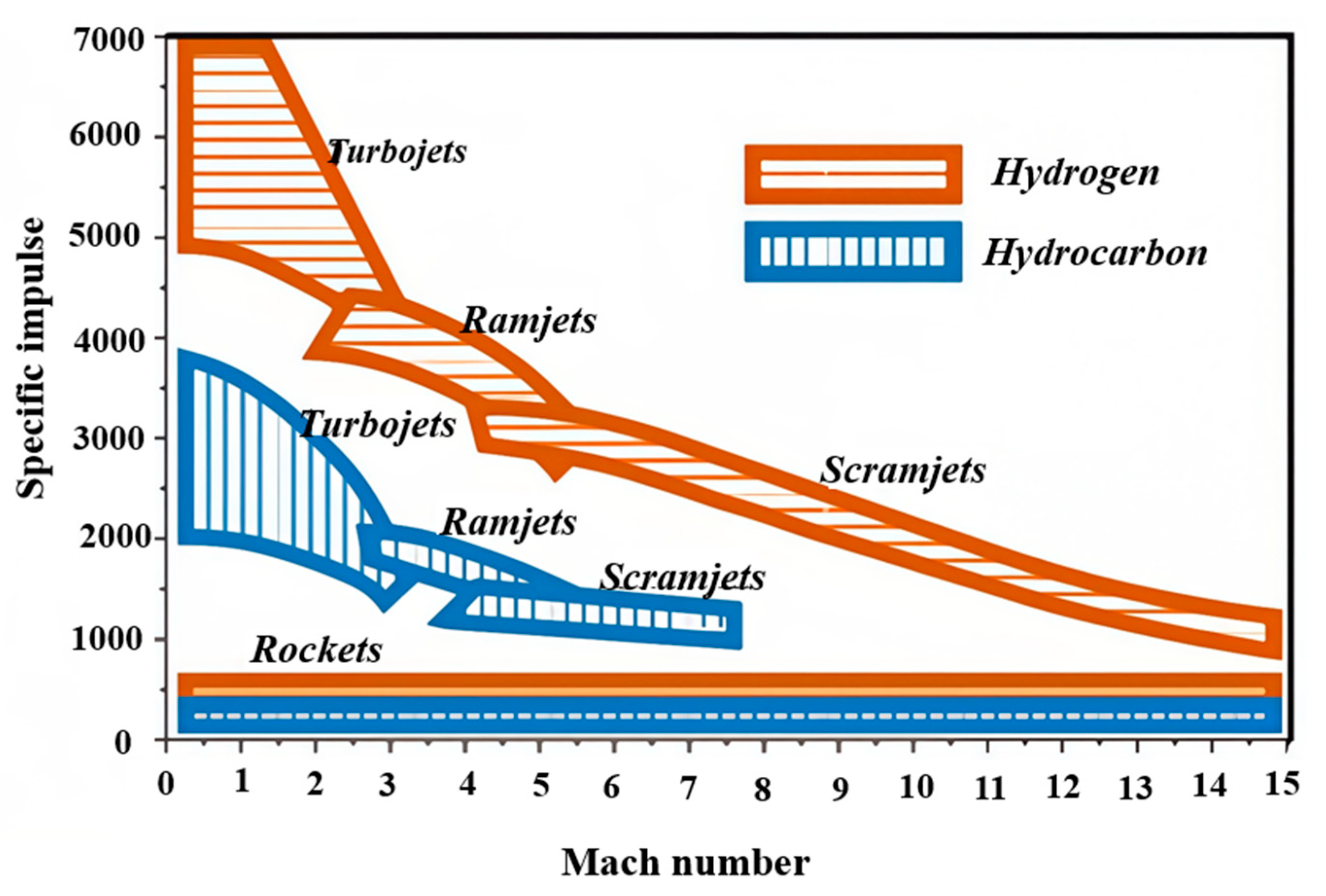


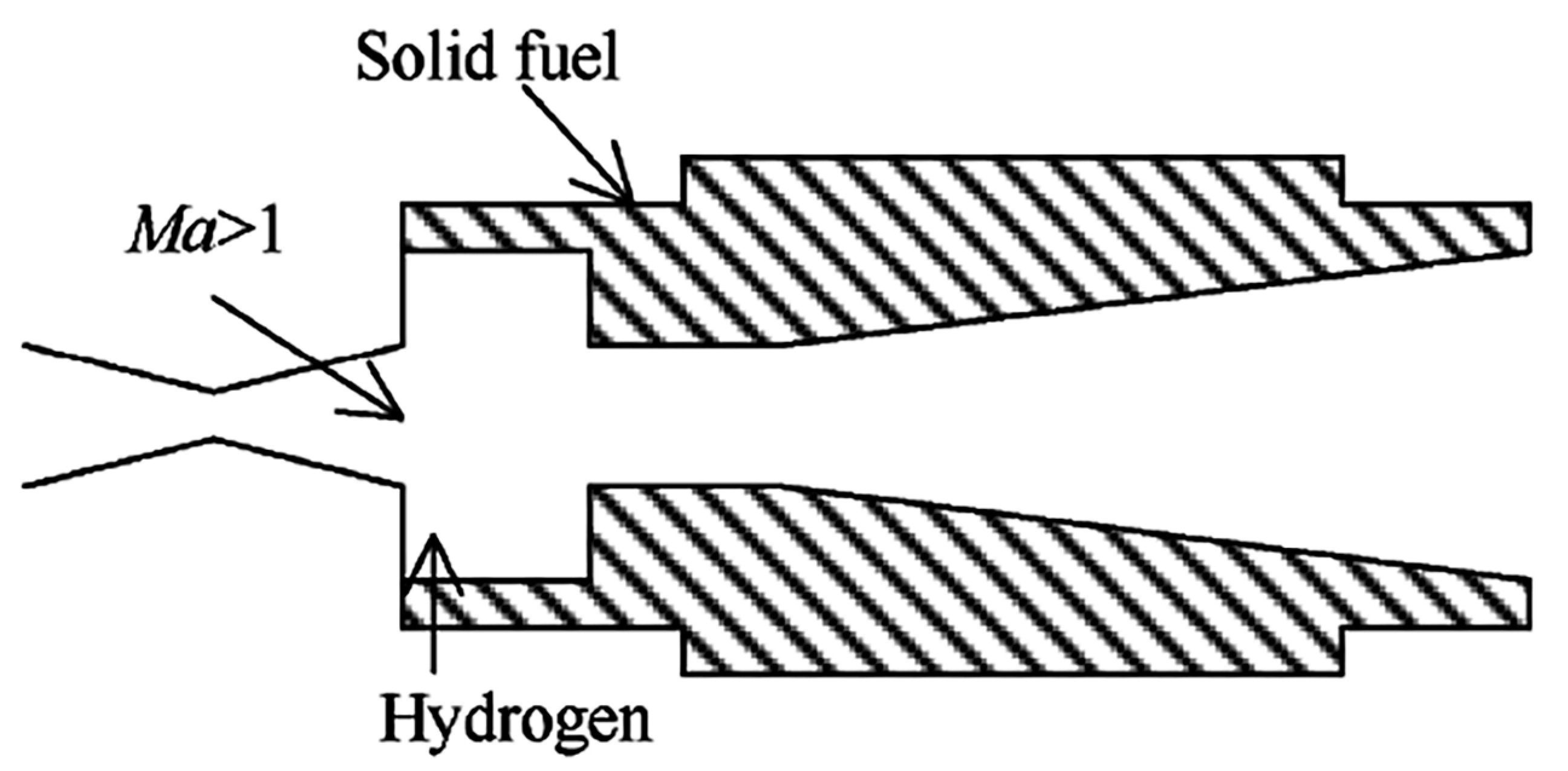


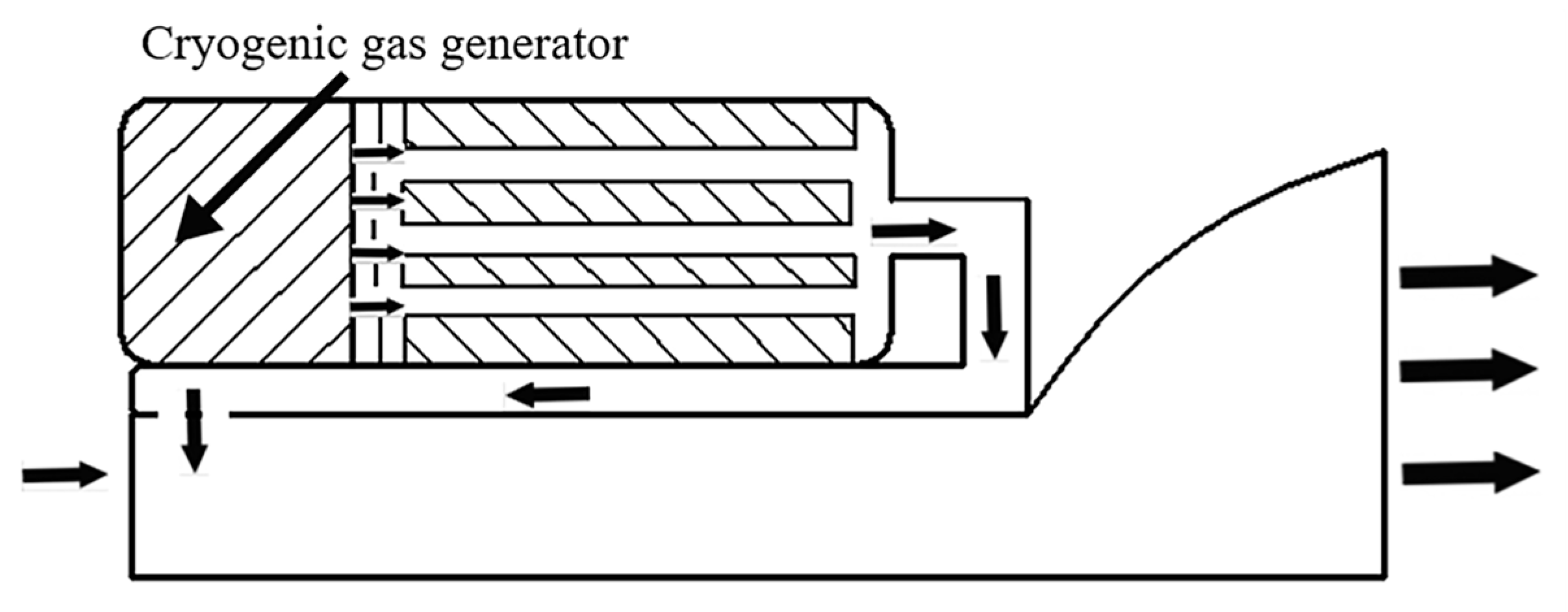
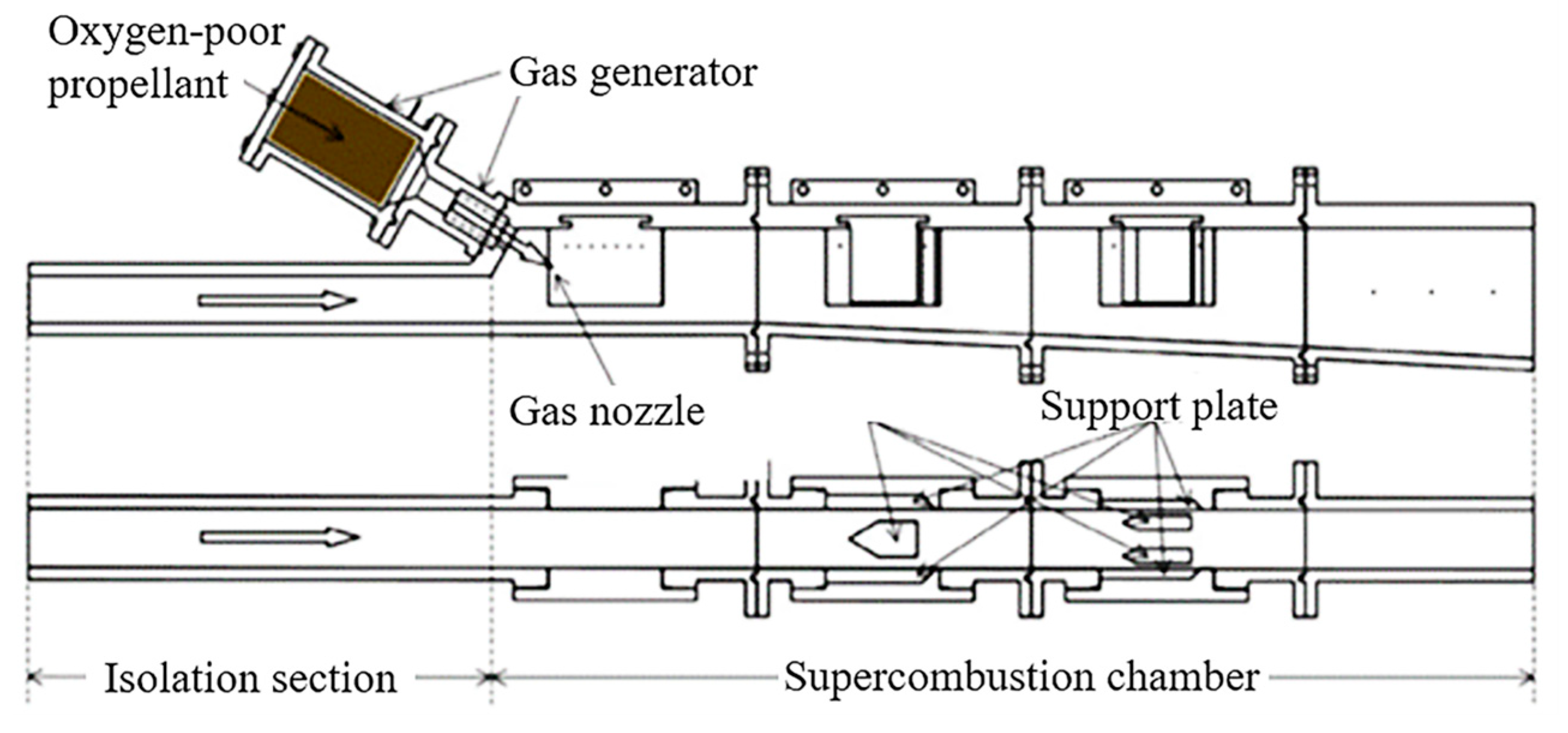
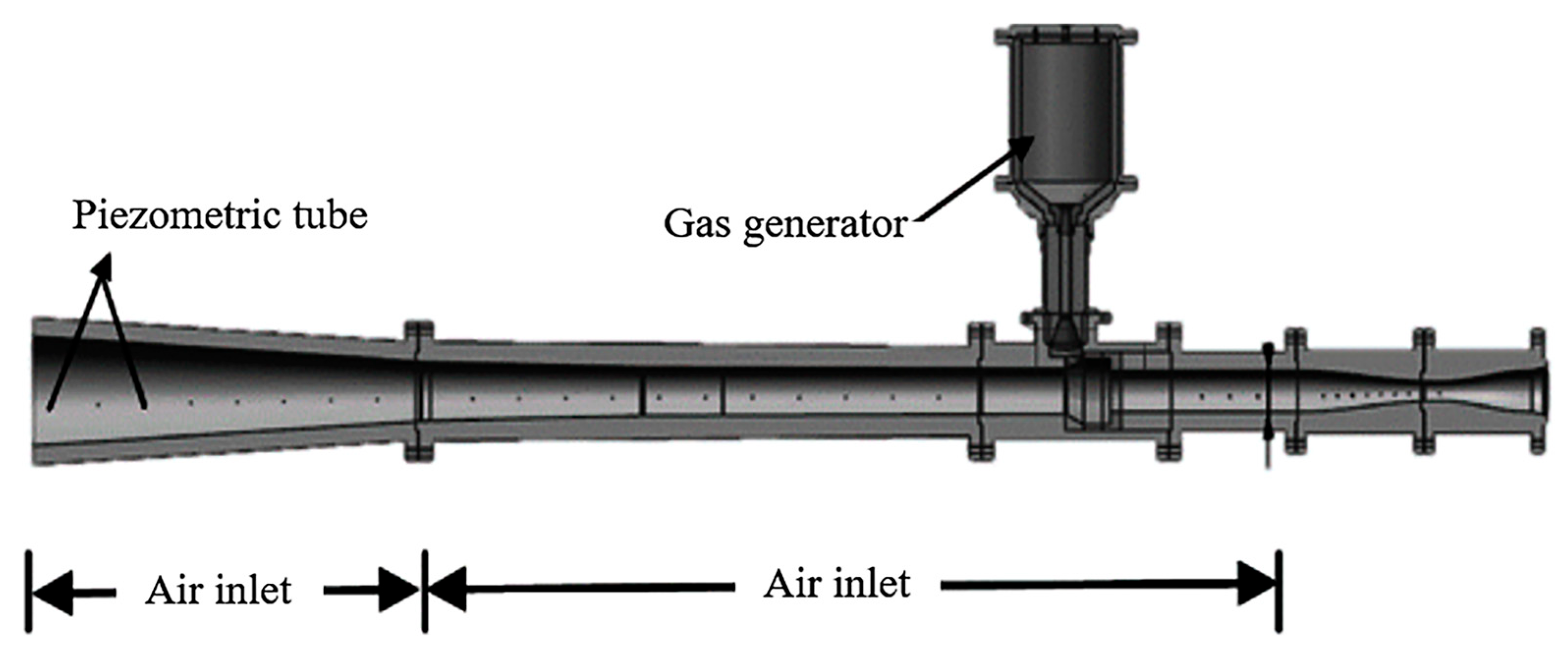
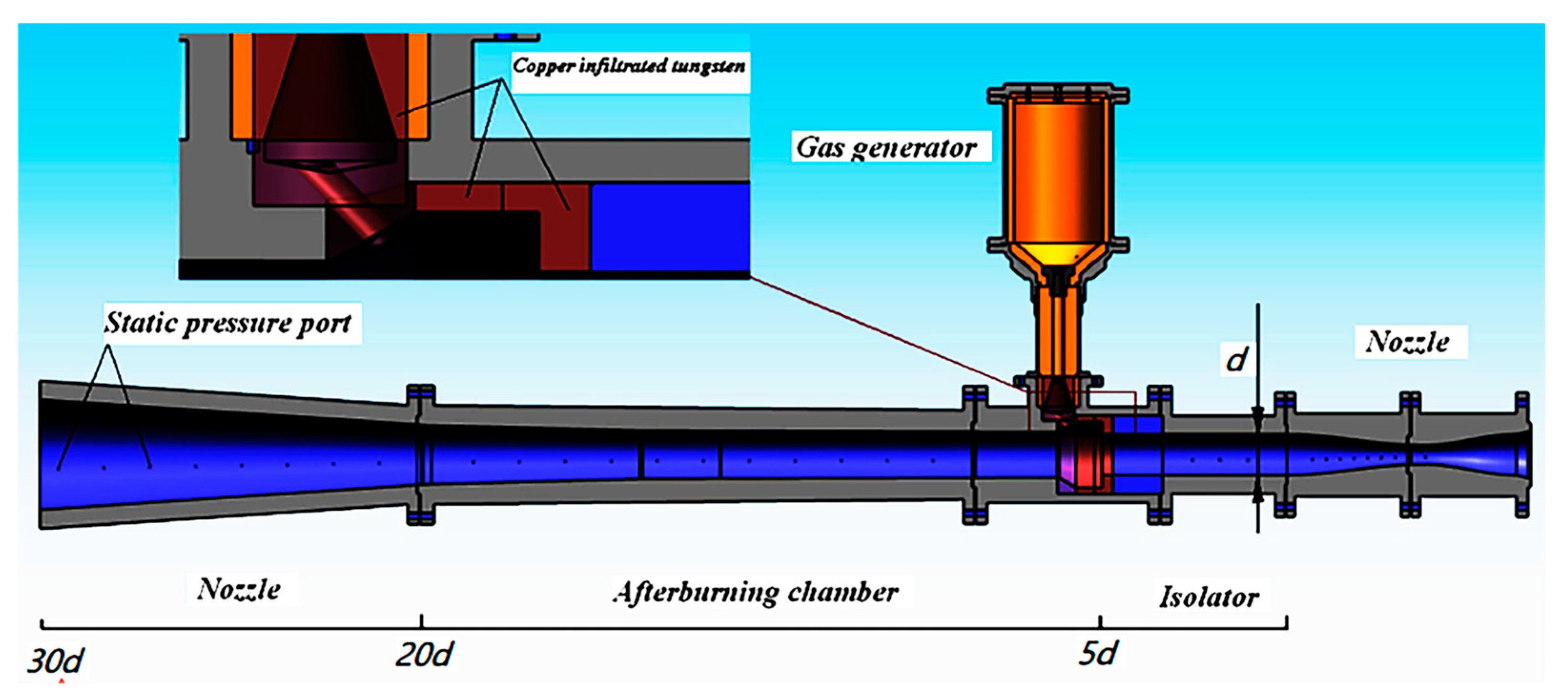
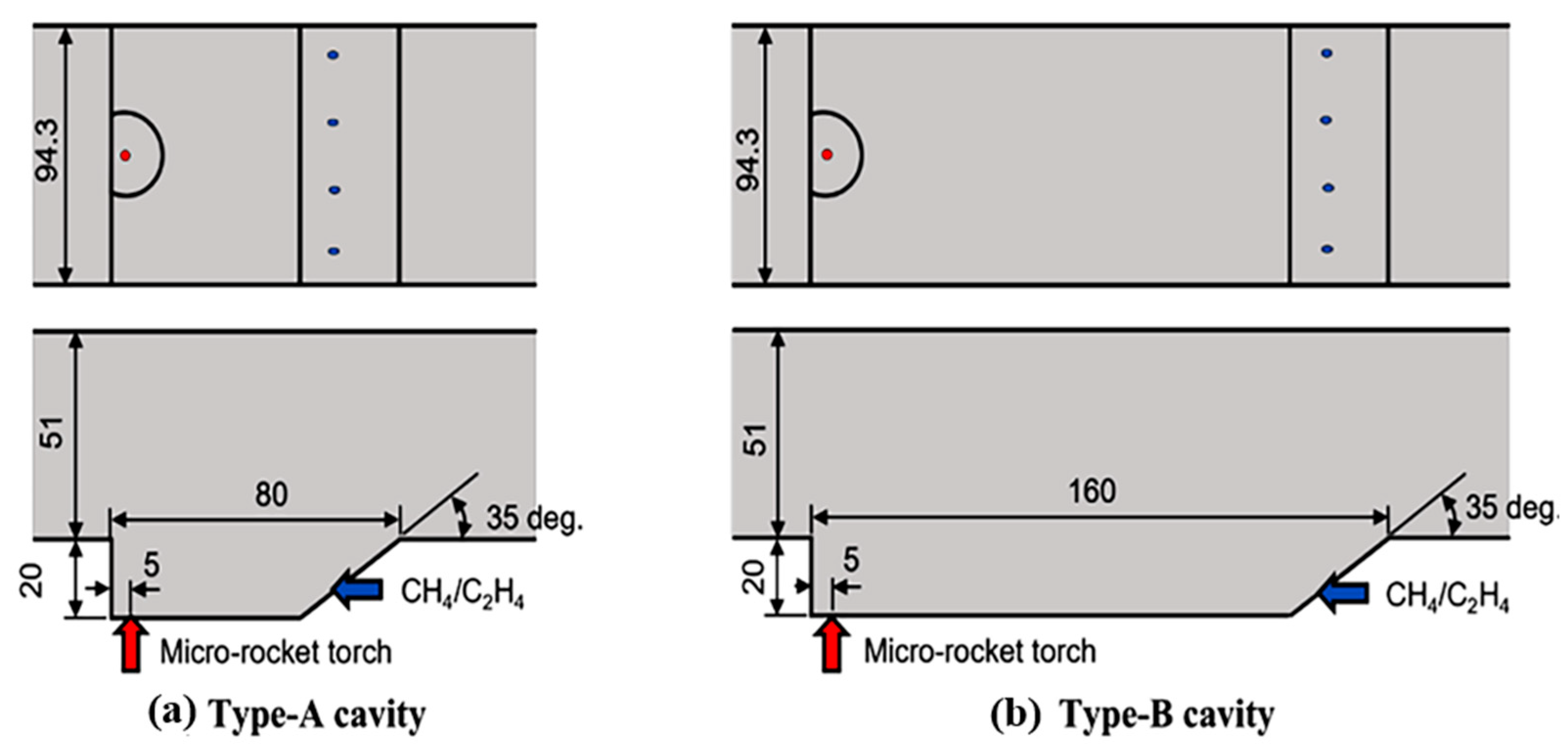


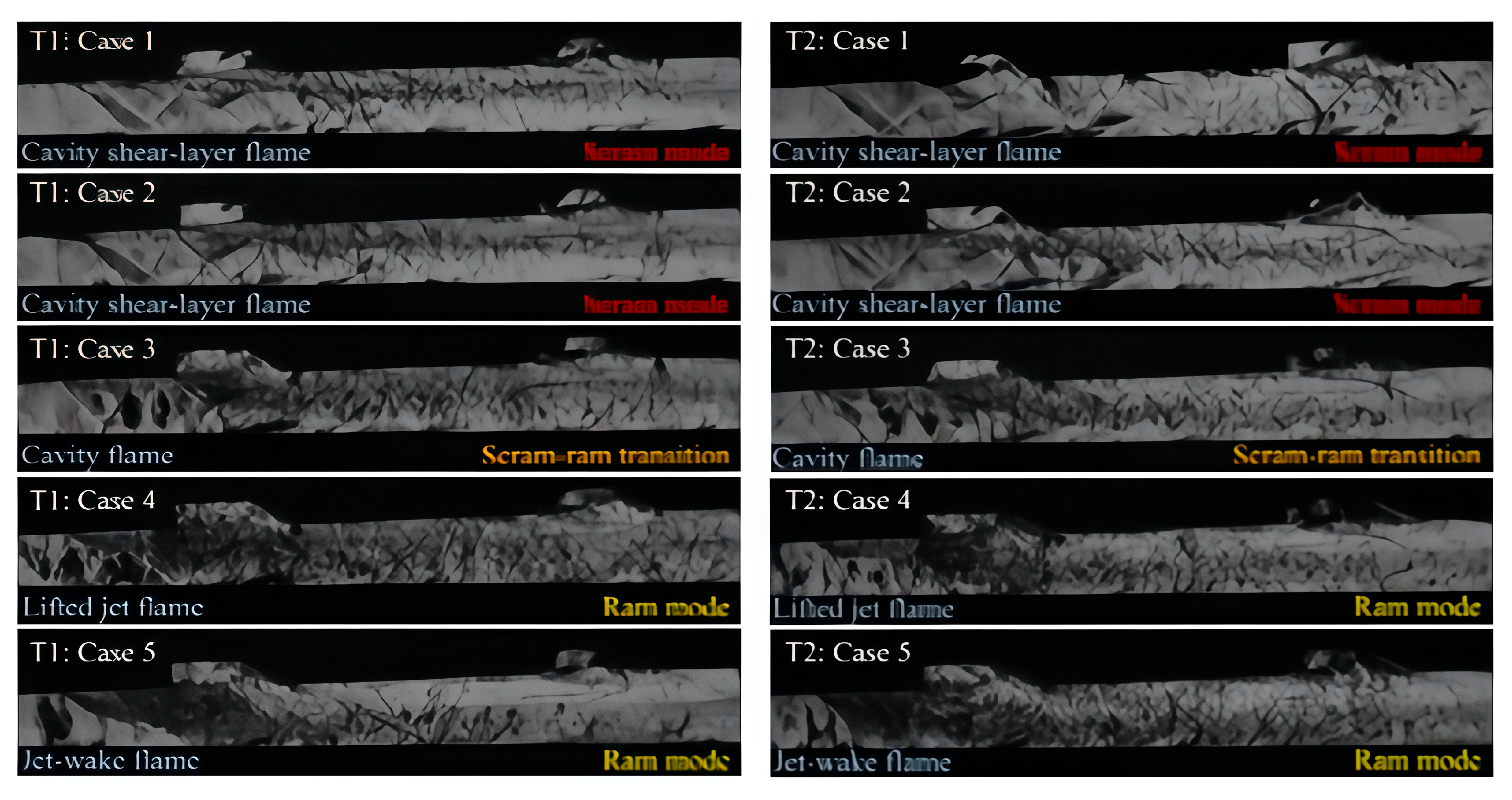
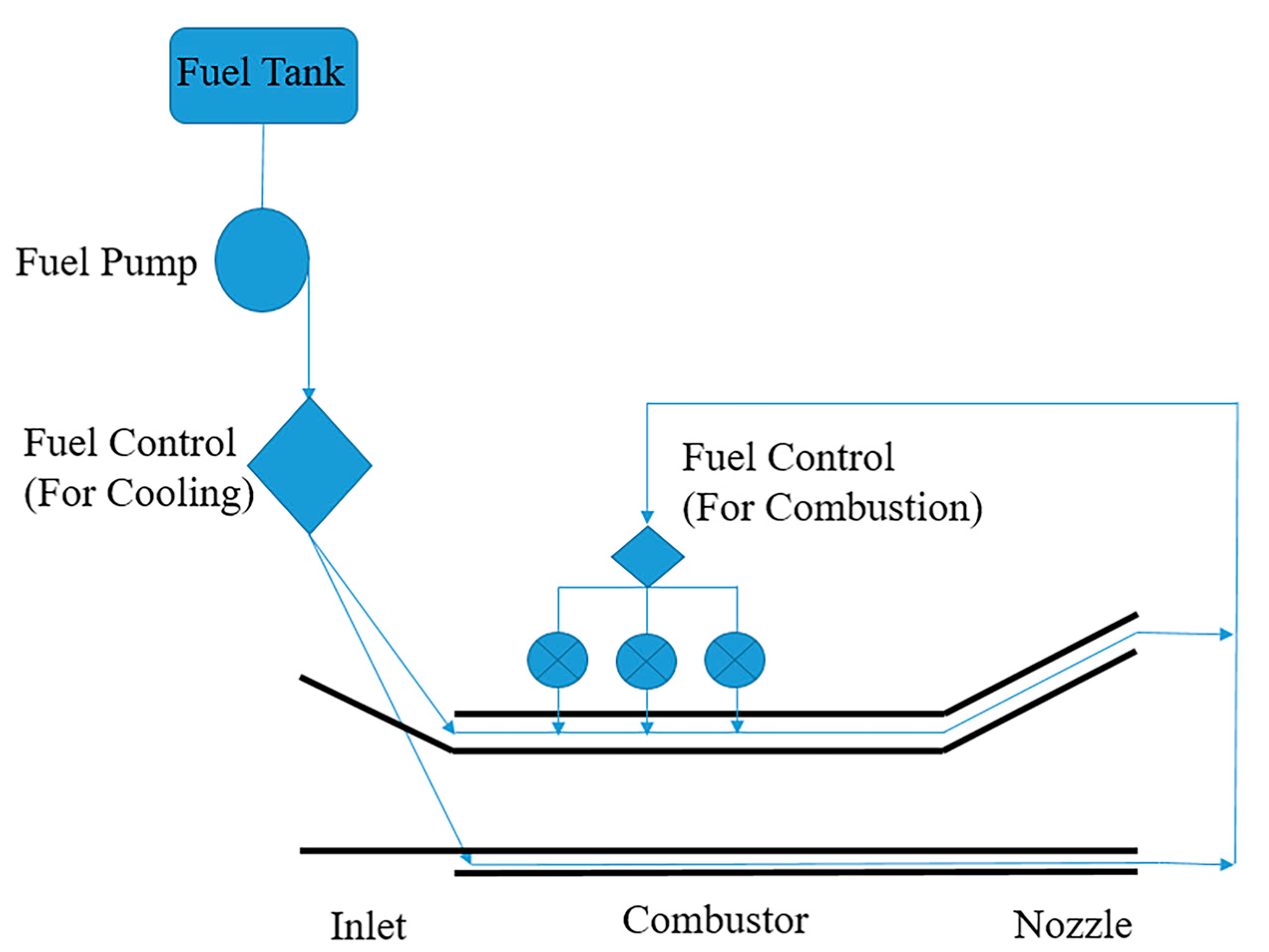
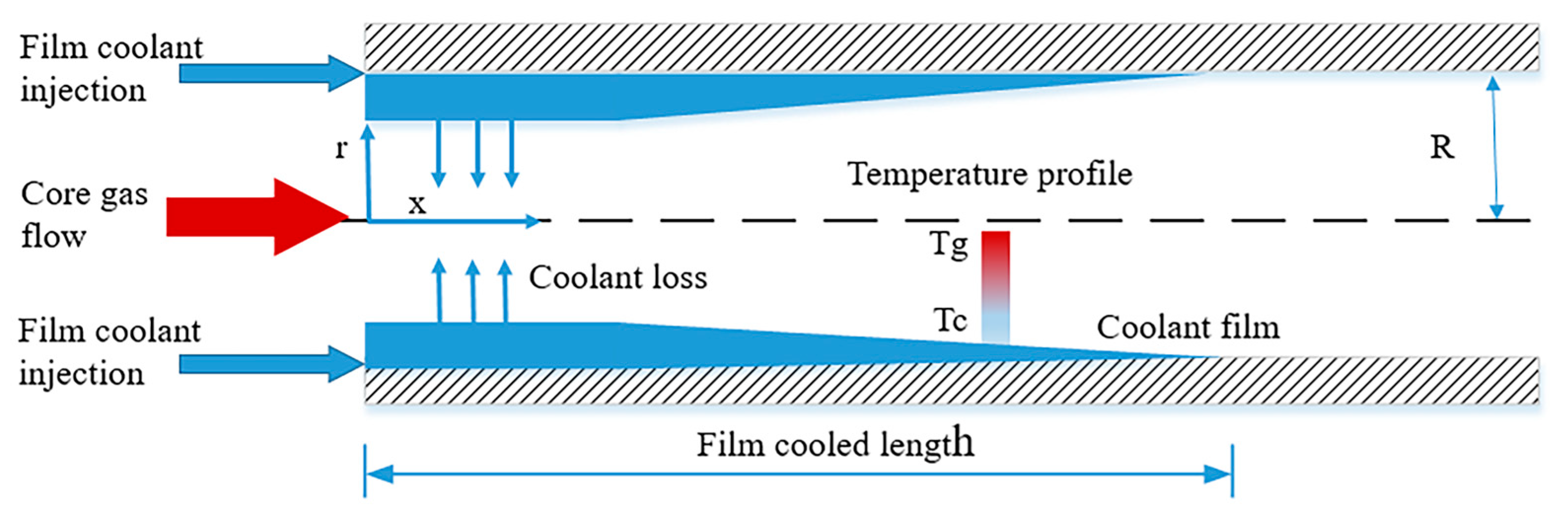

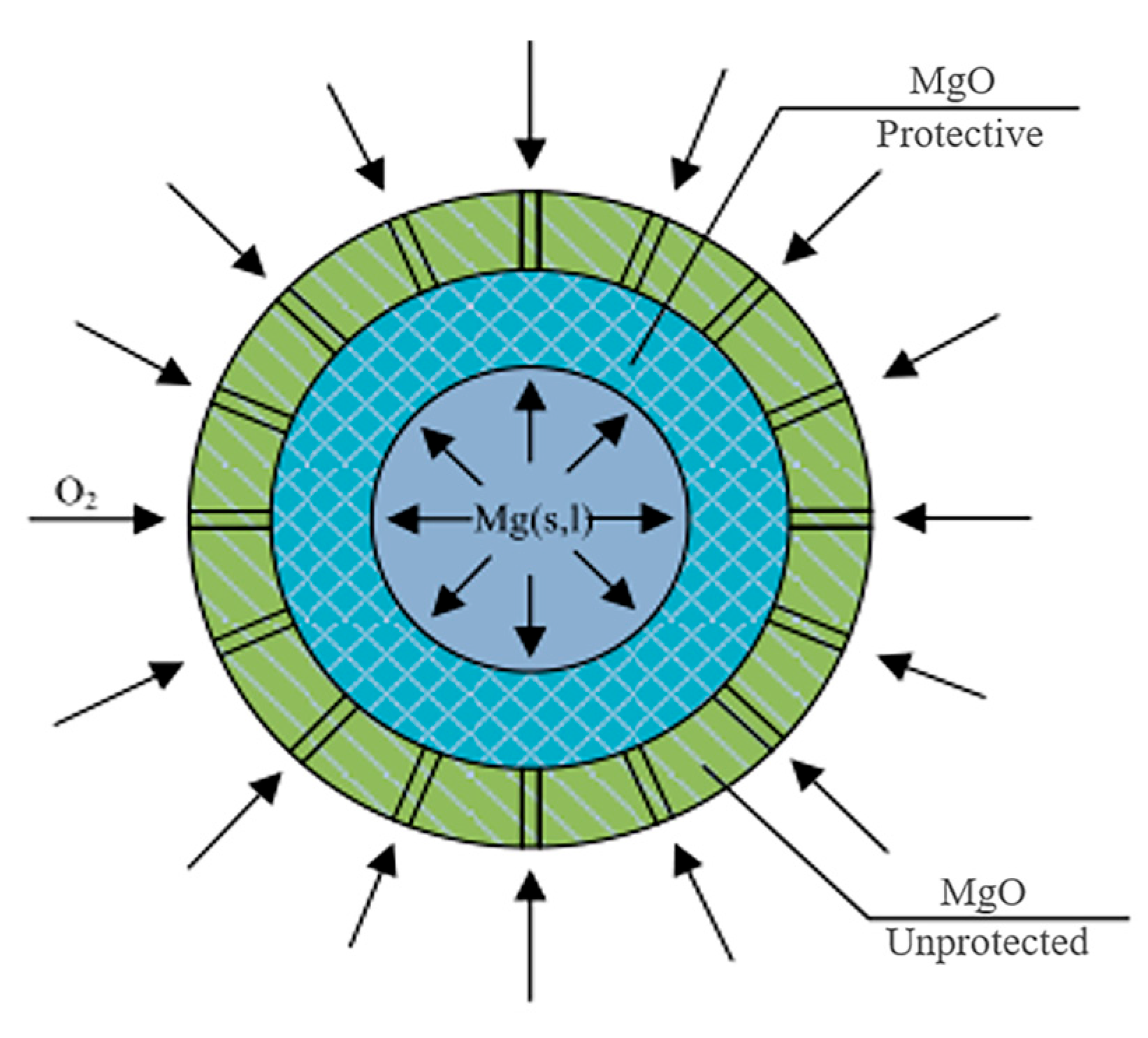

| Physical Mechanism | Mixing Device | Pressure Loss Effect | Flame Stabilization | |
|---|---|---|---|---|
| Active hybrid enhancement | Large-scale forced incentives | Vibrating splitter/wire [18] | Small | no |
| Pulsed jet [19,20] | Small | no | ||
| Helmholtz resonators [20] | Small | no | ||
| Piezoelectric actuators [21] | Small | no | ||
| Acoustic excitation [22] | Small | no | ||
| Passive hybrid enhancement | Acoustic excitation and flow vortex | Cavities [22,23,24,25,26,27] | Small | Yes |
| Flow vortex | Pneumatic slope [28] | Small | Yes | |
| Ramps [28] | Medium | Yes | ||
| Self-excited resonance and flow vortex | Backward-facing step [29] | Medium | Yes | |
| Flow vortex and Streamline orientation | Lobe mixers [21] | Medium | no | |
| Tabs [19] | Large | no | ||
| Vortex breakdown | Vortex/shock interaction [21] | Small | no | |
| Twist flow | Swirling Jets [21] | Small | no | |
| Oscillating structure excitation | Port geometry [22] | Small | no | |
| Transverse curvature | Transverse injection [22] | Small | no | |
| Large-scale excitation | Shock/shear layer interaction [22] | Small | no | |
| Self-excited resonance and increased fuel working hours | Counterflow [22] | Medium | no |
| Device Type | Advantages | Disadvantages |
|---|---|---|
| Transverse jet | Fast near-field mixing and good fuel penetration | Large total pressure loss and poor flame stability |
| Back step | The placement position and quantity are more flexible, the total flow pressure loss is small, and the mixing effect is considerable | The influence range is small, the slope front heat load is large, and so on |
| Support plate | Beneficial to improve the fuel distribution in the combustion chamber and reduce the heat load on the wall | Direct placement in the high-speed flow field will bring greater internal resistance and total pressure loss, and the fuel is at the rear of the support plate; low-speed zone combustion heat release will bring an excessive heat load |
| Cavity | Simple structure, small total pressure loss, good stable combustion, etc., and can effectively promote fuel mixing |
| Test Number | Fuel | Cavity | Equivalence Ratio |
|---|---|---|---|
| 1 | C2H4 | H9 | 0.34 |
| 2 | C2H4 | H9 | 0.39 |
| 3 | C2H4 | H9 | 0.50 |
| 4 | C2H4 | H9 | 0.35 |
| 5 | C2H4 | H9 | 0.40 |
| 6 | C2H4 | H9 | 0.51 |
| Fuel | Area (m2) | Air Flow (kg.s−1) | Density (kg.s−3) | Specific Thrust (m.s−1) | Specific Impulse (m.s−1) | Density Specific Impulse kg/(m2.s) |
|---|---|---|---|---|---|---|
| RP-3 | 808 | 831 | 12,123 | 9.8 × 106 | ||
| JP-7 | 0.04 | 2.83 | 806 | 850 | 12,210 | 9.84 × 106 |
| solid | 1600 | 1453 | 9790 | 1.57 × 107 |
| Ignition Process | Combustion Process |
|---|---|
| 2 B2O3 (l) + 2B (s) → 3 B2O2 (g) | 2B (s) + O2 (g) → B2O2 (g) |
| B2O3 (l) → B2O3 (g) | 4B (s) + 2HO2 (g) +3O2 (g) → 4HBO2 (g) |
| 4B (s) + 4B2O3 (l) + 6HO2 (g) + 3O2 (g) → 12HBO2 (g) | B (l) → B (g) |
Disclaimer/Publisher’s Note: The statements, opinions and data contained in all publications are solely those of the individual author(s) and contributor(s) and not of MDPI and/or the editor(s). MDPI and/or the editor(s) disclaim responsibility for any injury to people or property resulting from any ideas, methods, instructions or products referred to in the content. |
© 2025 by the authors. Licensee MDPI, Basel, Switzerland. This article is an open access article distributed under the terms and conditions of the Creative Commons Attribution (CC BY) license (https://creativecommons.org/licenses/by/4.0/).
Share and Cite
Yu, W.; Hu, Y.; Zhao, S.; Wang, R. Progress and Development of Solid-Fuel Scramjet Technologies. Aerospace 2025, 12, 351. https://doi.org/10.3390/aerospace12040351
Yu W, Hu Y, Zhao S, Wang R. Progress and Development of Solid-Fuel Scramjet Technologies. Aerospace. 2025; 12(4):351. https://doi.org/10.3390/aerospace12040351
Chicago/Turabian StyleYu, Wenfeng, Yun Hu, Shenghai Zhao, and Rongqiao Wang. 2025. "Progress and Development of Solid-Fuel Scramjet Technologies" Aerospace 12, no. 4: 351. https://doi.org/10.3390/aerospace12040351
APA StyleYu, W., Hu, Y., Zhao, S., & Wang, R. (2025). Progress and Development of Solid-Fuel Scramjet Technologies. Aerospace, 12(4), 351. https://doi.org/10.3390/aerospace12040351







